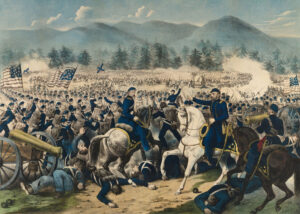Antietam, South Mountain & Harpers Ferry: A Battlefield Guide
by Ethan S. Rafuse, Bison Books, 2008, $21.95
“Now I know what to do!” Major General George B. McClellan reportedly exclaimed when handed a lost copy of Robert E. Lee’s Special Order No. 191 detailing movements for the Confederate army’s invasion of the North in September 1862. You’ll share Little Mac’s sentiment when you get a copy of Antietam, South Mountain & Harpers Ferry: A Battlefield Guide to tour those scenes of conflict that comprised the Maryland Campaign.
I personally felt the light bulb go on when I read the section on South Mountain— and I grew up within sight of that ridge, devouring much of the literature on America’s single bloodiest day and its preliminary engagements. But I never gained a greater grasp of the struggle for Fox’s Gap and Turner’s Gap until I traced this guide’s clearly plotted course through the rugged hillside. There, thanks to the foolproof directions, crisp prose and insightful commentary—along with meticulous topographical maps—I not only could place the troop positions, I could easily envision the ebb and flow of the fierce combat on those revered slopes.
The talented Ethan S. Rafuse proves to be an excellent choice to pen a sixth addition to Bison Books’ superb “This Hallowed Ground: Guides to Civil War Battlefields” series. His experience as a teacher of Civil War history at West Point, and as a member of the faculty at the U.S. Army Command and General Staff College, shows in the manner in which he synthesizes the technical elements of a military staff ride with the storytelling of popular battlefield tours to create a guide accessible to all levels of interest.
Whether you’re a serious scholar of the war, casual history buff or day-tripping tourist attracted to Antietam’s somber beauty, you’ll find this a worthy companion on your visit. Like its predecessors in the series, the guide follows the format established by editors Mark Grimsley, Brooks D. Simpson and Steven E. Woodworth. For each stop, there are concise driving and/or walking directions, a narrative of what happened there and analysis of the action, and vignettes taken from eyewitness accounts and anecdotes that paint a portrait of the human experience. A “terrain orientation” element is also included for many of the stops, as well as a thorough list of recommended reading.
The arrangement of the guide’s suggested stops makes both chronological and geographical sense in tracking the battle’s progress. There are 14 stops for Antietam, five for South Mountain and two for Harpers Ferry. Most also are divided into substops that further develop the action. Plus, you can take three optional excursions to explore specific phases in depth—Bloody Lane, Burnside Bridge and Boteler’s Ford, which includes the Battle of Shepherdstown.
The 263-page guide contains 49 useful maps by Christopher L. Brest. Most diagram the action at the brigade or regimental level, and a few display the strategic area of operations. The natural and period terrain features (e.g., hills, fields, roads, buildings, woods and bridges) are all denoted to help show how the landscape influenced the fighting. Modern highways and the park’s network of thoroughfares are also shown.
Included in the guide are succinct essays on the organization, weapons and tactics of Civil War armies as well as on reading terrain and estimating distances. There also are Orders of Battle for both sides.
What you won’t find are the items usually included in typical tourist tomes. No information on gas, food and lodging. No highlights of local festivals or shopping. No other nearby attractions (although Rafuse does note a few points of interest along the tour route, such as the first monument to George Washington built in 1827 atop South Mountain, or Harpers Ferry’s significance in America’s industrialization and transportation history).
You also won’t read tales of Union General Ambrose Burnside pouting away the hours at the Rohrbach Bridge like a spurned prom date, or Rebel General Roswell Ripley and his brigade wandering away from the fight at Fox’s Gap like some military Mr. Magoo. As he did in his book McClellan’s War, Rafuse avoids repeating the myths, clichés and other hoary chestnuts from older, less accurate accounts.
Other than a few typos— the most egregious being the map on P. 77 mislabeling a unit of Greene’s Federal division as commanded by “Stainrock,” when it was Colonel Henry J. Stainrook’s brigade—the guide has no real faults. My only quibble is with the book’s sequence, which runs opposite to the campaign’s chronology. This is understandable, probably because of appeal or tour length, but the order may confuse novice students of the battle while distracting old campaign hands from enjoying it cover to cover as a historical narrative.
Still, this is more than just an exceptional guide book. Rafuse has used original sources, the most recent scholarship, input from an impressive team of experts and his talents as a writer to craft a readable, revealing and perceptive short study of a momentous campaign.
Originally published in the September 2009 issue of America’s Civil War. To subscribe, click here.




